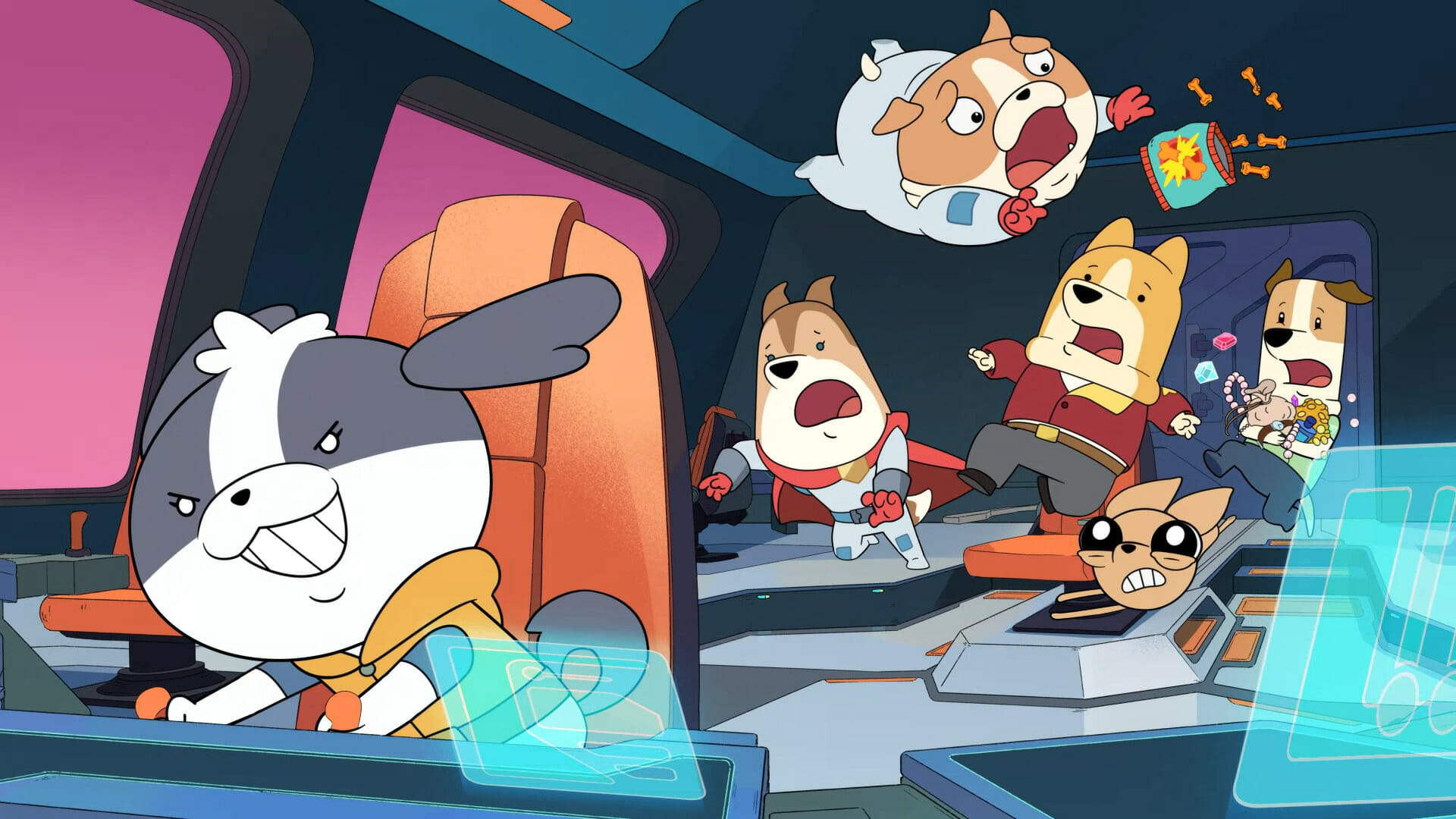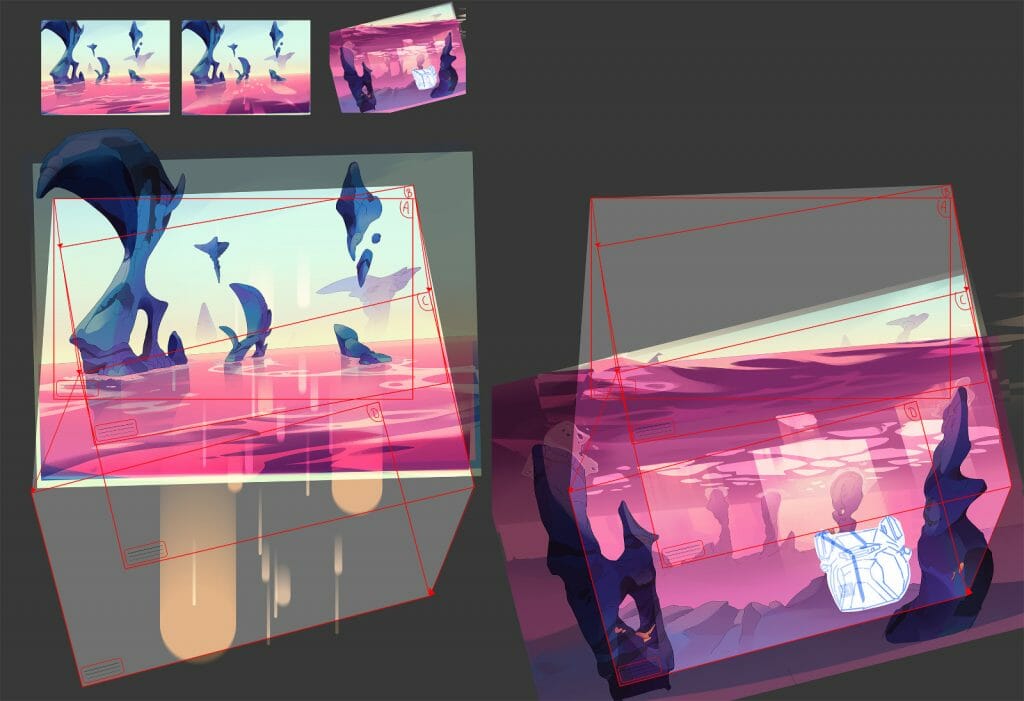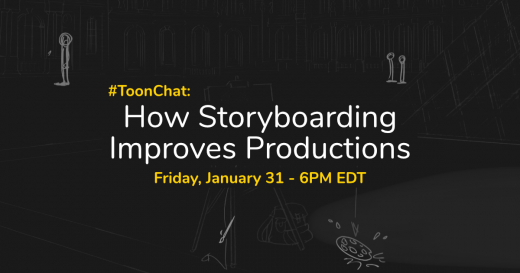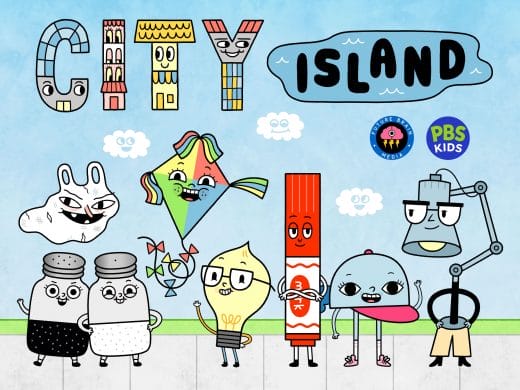
Dogs have history with space travel. Our four-legged friends are among the first living beings to be launched into the cosmos. A new animated series, Dogs in Space, takes this idea to new heights, and imagines an advanced spacecraft manned bravely by an all-canine crew. Brought to you by the talented team of artists at Atomic Cartoons working across Storyboard Pro and Harmony, the show’s creation was a collaborative process with astronomical results.
Dogs in Space showcases unique alien character design, eye-catching colour palettes and truly cosmic backgrounds. We caught up with Darrell Yeo (Line Producer) and Carl Upsdell (Animation Director) to discuss Dogs in Space’s unique art style, and some of the techniques that went into the space-faring canine adventure. They discuss their use of Harmony’s 3D integration and comping tools, and how Storyboard Pro allowed them to collaborate remotely and overcome challenges on the project, with plenty of valuable tips for animation teams.
As well as discussing how they created the show’s interplanetary environments, the crew at Atomic Cartoons opens the hood on some of the incredible vehicle design we see in the show, like the otherworldly spacecraft that were created using both Maya and Harmony. They also provide advice for animators seeking opportunities at a leading industry studio. Check out Dogs in Space and read our full interview below…
In your own words, what is Dogs In Space about?
Darrell: Dogs in Space is a fun, emotional adventure series about a ragtag group of dogs, who are Earth’s last resort! They are searching the far reaches of the galaxies to find a new planet that will not only save humanity, but will also allow them to return home to their beloved owners. Along the way, they encounter all sorts of strange creatures, fantastic places and engage in hijinks!
Can you introduce the team members who worked on the show?
Darrell: There were so many great and immensely talented folk who worked on the show, which makes it difficult to name them all! Here we have our Animation Director, Carl Upsdell, and myself as the Line Producer at our Vancouver studio, where we managed the production and post-production work. We also had a team in LA working on pre-production, led by Jeremiah Cortez (Show Creator), Adam Henry (Executive Producer), Patty Jausoro (Line Producer) and Liz Artinian (Art Director).
I would encourage anyone interested to check out the episode’s end credits, to see all of the amazing team members we had on the show. Each episode’s credits have a unique colour palette and song that ties to the episode as well.
How would you describe the art style in Dogs in Space, and what are its identifiable features?
Darrell: The Dogs in Space art style is very much a visual marriage between the various sensibilities of our team coming together, where line emphasized story and colour emphasized emotion.
Jeremiah Cortez, our showrunner and show creator, determined the look of the dogs with his natural drawing style, which is quite cute and accessible with an emphasis on thick and rounded shape-language. Adam Burnier, our character supervisor, then took those designs and ran with them. Our art director, Liz Artinian, created a background world with more texture, dimension, and seriousness than the characters. And then mixed that together with colour palettes and lighting. Emily Tetri, our colour supervisor, really pushed challenging and inventive colour combinations, while Oliver Tseng, our background design supervisor, drew wonderfully detailed backgrounds inspired by Moebius.
What was the storyboarding process and how did Storyboard Pro prove useful?
Darrell: Dogs in Space was produced almost entirely at home through the pandemic. Each episode was boarded by a team of artists. Working from home, it made file-sharing and collaboration even more of a necessity than ever before. Storyboard Pro proved incredibly useful by easily allowing the team to split and join files together, as we would often need to pass sequences back and forth among artists.
Of course, that brings with it a few production hurdles, but Storyboard Pro also had functions that allowed the team to overcome those, such as painlessly adjusting scene and sequence numbering.
Also, we had a number of spaceships in our show. Being able to import FBX files to give the board teams direct access to 3D assets in the software is always handy!
Can you talk about the character design and/or rigging process that gave Garbage and the rest of the crew their personality?
Darrell: As mentioned, Jeremiah’s natural drawing style and original designs provided the basis of each character’s personality, which we carried over into the animation. The builds and animation teams worked closely with the design team, where designs provide character poses that help guide and inform the personality and acting, regardless if it was used in the build or simply served as a reference. The synergy between departments also helped. We had animation-friendly designs that allowed us to push the acting and get as much personality out of the characters as possible.
For the rigging of Garbage, we tried to take a balanced approach. We had deformers on most pieces and the characters could fully turn. We had seamless joints with built-in creases but we also had the ability to draw new hands and mouth shapes to add more personality in the expressions and poses. Overall, it’s always a balance between adding function without over-building and weighing down the rig.
The rest of the canine crew each presented their own challenges. Each character had their own design that represented their personality. This meant that we needed to adapt our rigging to include the unique shapes. Ultimately, we were able to make a rig that was fairly consistent across the cast of characters without losing functionality.
How did the background art process differ between the space environments and the different planets the crew explore?
Darrell: For the space environments, any planetary structure or spaceship-related element was drawn with line and everything else was painted. Space was meant to be graphic yet kinetic and always awe-inspiring. This is where our dogs would get that “fish out of water” feeling.
Liz and Emily worked on finding outside-the-box colour theories for each planetary system. They wanted the art of each space environment to tie into the theme of each planet and to the emotional arc of each episode. Due to being in space and in spaceships a lot of the time, there weren’t set times of day to play with. Instead, they used the colour of space to help shift the emotional progression of the story.
For example: In the episode of Season 1, “Stay,” where the dogs encounter the shape-shifting aliens, the environments take on a ‘60s Stepford Wives vibe with a planet bathed in pinks and teal light, contrasted with a gray-green space and hot pink stars. The only time we see black space, as we know it, is in the final episode. Which is fitting since we’re back orbiting Earth.
If you look at the space and planet palettes across both seasons, you’ll see a distinctive, pre-planned emotional arc.

What are the challenges when animating large creatures or spacecraft?
Carl: The large characters had to have a real sense of scale. One of the ways we tried to achieve that was to lean on perspective by designing special poses. These would help give animators the necessary reference for pushing their shots further.
For the spaceships, we used 3D Maya plates and matched them in Harmony. Alternatively, we would occasionally bring the 3D model into Harmony and then match that back to Maya. Either way, it took time and we had to make sure it was going to work for all of the other departments before bringing it all back together for the final compositing.
Storyboards helped in a big way, as well, by allowing us to plan how to handle some of the drastic size differences or spaceship action!
Which tools within Harmony helped the team the most on the Dogs In Space project?
Carl: It’s hard to pinpoint any one tool as the most helpful, as we used a lot of the built-in Harmony tools. From managing line thickness to creating full comp treatments for colour tinting, glow, motion blur, we were able to utilize a lot of tools and took advantage of the technical capabilities of the software in order to achieve the creative vision.
With Harmony 20, we could also fully integrate Harmony into our Production pipeline using Shotgrid. This allowed us to tag and import assets, control colour palettes and import library references and create reuse that could be tracked by production.
Can you tell us about a day in the life of a member of the team at Atomic Cartoons?
Darrell: We started this project just months before the pandemic hit and therefore it was almost entirely completed through work-from-home. So I’m sure each team member had a slightly different experience. But we managed to keep consistency and provide support by making sure we maintained tight communication. There was a steep learning curve with that sudden change in our working environment.Over time, we made sure to reassess our processes and maintain a tight meeting schedule so everyone felt supported without feeling overwhelmed or too bogged down by meetings.
We had catered chat groups to each team and department, and maintained steady kickoffs and reviews to provide that structure, even though everyone was working in different locations.
Beyond work, we hosted a few Zoom team events where we played online games such as Bingo. We even attempted to sing Jingle Bells during the holidays on an unmuted 100-plus-person call!
Where can our readers learn about career opportunities at Atomic and what are you on the lookout for?
Darrell: You can keep an eye out on our website as it’s frequently updated with job postings. Also follow Atomic Cartoons on LinkedIn to see our job postings and announcements on our career fair appearances. Things are always changing and we’re always excited to meet with great people across both 2D and 3D.
- Ready to seek out more episodes of Dogs in Space? The first two seasons are currently available to stream on Netflix.
- Interested in joining the crew at Atomic Cartoons? For current listings in LA, Vancouver and Ottawa, visit the studio’s careers page.
- Want to move up to a new role at your studio in compositing, rigging or animation? Learn more about Toon Boom’s instructor-led training courses.



